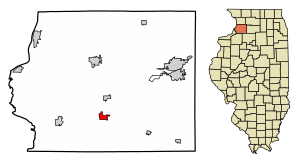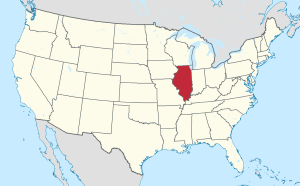Prophetstown, Illinois facts for kids
Quick facts for kids
Prophetstown
|
|
|---|---|

Location of Prophetstown in Whiteside County, Illinois
|
|

Location of Illinois in the United States
|
|
| Country | United States |
| State | Illinois |
| County | Whiteside |
| Area | |
| • Total | 1.37 sq mi (3.54 km2) |
| • Land | 1.34 sq mi (3.47 km2) |
| • Water | 0.03 sq mi (0.07 km2) |
| Population
(2020)
|
|
| • Total | 1,946 |
| • Density | 1,453.32/sq mi (561.11/km2) |
| Time zone | UTC-6 (CST) |
| • Summer (DST) | UTC-5 (CDT) |
| ZIP Code(s) |
61277
|
| Area code(s) | 815 |
| FIPS code | 17-61977 |
Prophetstown is a city located in Whiteside County, Illinois, in the United States. In 2010, about 2,080 people lived there. This was a small increase from the year 2000.
Contents
Geography of Prophetstown
Prophetstown is found at specific coordinates: 41°40′14″N 89°56′9″W. This helps us pinpoint its exact spot on a map.
The city covers a total area of about 1.394 square miles (3.61 square kilometers). Most of this area, about 1.37 square miles (3.55 square kilometers), is land. Only a small part, about 0.024 square miles (0.062 square kilometers), is water.
History of Prophetstown
Early Beginnings and Native American History
In 1825, a special agreement was made. It mentioned a "Winnebago village" about 40 miles up the Rock River. This village was a boundary point for the Winnebago people. Its location matches where Prophetstown is today.
Prophetstown sits on the site of a village once led by the Winnebago prophet. In 1832, Illinois volunteers destroyed this village. This event was the first act of fighting in the Black Hawk War. The city of Prophetstown was named after Wabokieshiek (White Cloud). He was a prophet who lived on this land.
Wabokieshiek gave advice to Black Hawk. He also took part in the Black Hawk War. Wabokieshiek and his followers, the Sauk people, lived where Prophetstown State Park is now. They left the area in 1832 when the Black Hawk War ended. Wabokieshiek was captured by the United States. This area is now a state park. However, it was once home to 14 different villages.
Interesting Facts and Community Life
People believe that in the 1800s, residents of Prophetstown asked the U.S. government to move the capital from Washington D.C. to Prophetstown. They thought Prophetstown was in the very center of the lower 48 states.
Prophetstown used to have fun community events. One was called Cruise Night. This event showed off many classic cars at Eclipse Park in the town center. Over time, the event became less popular. A memorial was then built in the park. It honors those who served in the Armed Forces.
Prophetstown is still well-known for its large Fourth of July fireworks shows. These shows are some of the biggest in the area. The city also hosts a Lighted Christmas Parade. This parade is a main event that starts the holiday season. It happens on the Saturday before Thanksgiving. Prophetstown is part of the Illinois Main Street Community program. Its downtown area has historical murals and Eclipse Square Park. You can also find various stores and restaurants there.
Population and People
| Historical population | |||
|---|---|---|---|
| Census | Pop. | %± | |
| 1870 | 276 | — | |
| 1880 | 803 | 190.9% | |
| 1890 | 694 | −13.6% | |
| 1900 | 1,143 | 64.7% | |
| 1910 | 1,083 | −5.2% | |
| 1920 | 1,159 | 7.0% | |
| 1930 | 1,353 | 16.7% | |
| 1940 | 1,469 | 8.6% | |
| 1950 | 1,691 | 15.1% | |
| 1960 | 1,802 | 6.6% | |
| 1970 | 1,915 | 6.3% | |
| 1980 | 2,141 | 11.8% | |
| 1990 | 1,749 | −18.3% | |
| 2000 | 2,023 | 15.7% | |
| 2010 | 2,080 | 2.8% | |
| 2020 | 1,946 | −6.4% | |
| U.S. Decennial Census | |||
In the year 2000, there were 2,023 people living in Prophetstown. These people made up 809 households and 533 families. The city had about 1,484.5 people per square mile. There were also 865 homes, with about 634.7 homes per square mile.
Most of the people in the city were White (97.92%). A smaller number were African American (0.89%), Native American (0.10%), or Asian (0.10%). Some people (0.25%) were from other races, and 0.74% were from two or more races. About 1.14% of the population were Hispanic or Latino.
Out of the 809 households, 25.5% had children under 18 living with them. Most households (56.1%) were married couples living together. About 7.4% had a female head of household with no husband. Also, 34.0% were not families. Many households (31.6%) were made up of just one person. About 17.8% of these were people aged 65 or older living alone. The average household had 2.31 people. The average family had 2.89 people.
The population in the city was spread out by age. About 21.4% were under 18 years old. Around 7.2% were between 18 and 24. About 25.2% were between 25 and 44. Another 23.3% were between 45 and 64. Finally, 23.0% were 65 years or older. The average age was 43 years. For every 100 females, there were about 93.4 males. For every 100 females aged 18 and over, there were about 88.3 males.
The average income for a household in the city was $37,452. For a family, the average income was $47,589. Males earned an average of $33,828, while females earned $21,438. The average income per person in the city was $19,572. About 3.9% of families and 9.5% of all people lived below the poverty line. This included 8.4% of those under 18 and 4.0% of those 65 or older.
Education in Prophetstown
The public schools in Prophetstown are part of the Prophetstown-Lyndon-Tampico Community Unit School District 3.
There is also a private school nearby called Christ Lutheran School. It is located in Sterling. This school welcomes students from different religious backgrounds. Students come from towns like Walnut to Milledgeville. They also come from Morrison to Dixon. Christ Lutheran School is part of the largest network of Protestant schools in the U.S. It offers education for students from age 3 up to 8th grade.
Notable People from Prophetstown
- Bret Bielema (born 1970) is the head football coach for the University of Illinois.
- George S. Brydia (1887–1970) was a journalist, salesman, and politician. He also served as the mayor of Prophetstown.
- Claude A. Fuller was a former congressman from Arkansas. He was born in Prophetstown in 1876.
- Paul E. Rink (1916–2000) was an Illinois state legislator and judge. He was born on a farm near Prophetstown.
See also
 In Spanish: Prophetstown (Illinois) para niños
In Spanish: Prophetstown (Illinois) para niños

